Overview
This article offers vital insights into the 2025 VA Disability Pay Chart, focusing on the compensation rates that matter most to you. We understand that navigating these changes can be overwhelming, especially with the impact of cost-of-living adjustments and eligibility requirements for veterans. By detailing the payment increases and recent legislative changes, we aim to clarify these updates, helping you optimize your benefits.
It's common to feel uncertain about how these adjustments affect your situation. We’re here to help you understand the complexities of the VA claims process. Knowing these details can empower you to make informed decisions and ensure you receive the support you deserve. Remember, you are not alone in this journey; we are committed to guiding you every step of the way.
Introduction
In the ever-changing landscape of veteran support, the 2025 VA Disability Pay Chart stands out as a crucial resource for former service members seeking clarity on their benefits. We understand that navigating this information can feel overwhelming. This article offers essential insights, highlighting key compensation rates, legislative changes, and the impact of cost-of-living adjustments that could significantly influence your financial well-being.
It's common to have questions during such transitions:
- How can you effectively optimize your benefits amidst these changes?
- What steps must you take to ensure you are not left behind in the complexities of the VA system?
Together, we will explore these important topics, providing you with the guidance you need as you embark on this journey.
Turnout: Streamline Your VA Disability Claims Process
Turnout is transforming the landscape of VA disability applications for former service members by harnessing the power of AI technology. This innovative approach not only streamlines the process but also makes it more accessible and less intimidating. With Jake, the AI case quarterback, experienced individuals receive timely updates, efficient document management, and proactive follow-ups, ensuring their requests progress smoothly and without unnecessary delays. This modern method stands in stark contrast to traditional systems, which often leave former service members feeling overwhelmed and unsupported.
The effective use of AI in consumer advocacy is exemplified by partnerships like that of the Queen Anne’s County Veteran and Military Support Alliance (VAMSA) and Vet Mentor AI, aimed at enhancing the efficiency of VA disability submission processes. As Eric Johnson, executive director of VAMSA, insightfully remarked, "At the end of the day it’s going to give us valuable information and we’re still going to deliberately go through it and add the human touch." Such initiatives are expected to significantly reduce the time and effort required for former military personnel to submit their requests, ultimately improving access to the benefits they have rightfully earned.
As Turnout supports over 2 million former service members in navigating the complexities of the VA process, the positive impact of AI on claims processing efficiency is evident. By optimizing procedures and providing a personal touch through non-lawyer advocates, Turnout ensures that former service members receive the timely support they need. This transformation in services for former military personnel is not merely about technology; it’s about empowering them to reclaim their benefits with confidence. You are not alone in this journey, and we are here to help.

2025 VA Disability Pay Chart: Key Compensation Rates Explained
The monthly payment rates based on impairment ratings are highlighted in the 2025 VA disability pay chart, an important aspect for our veterans. For instance, if you are assessed with a 100% disability, you will receive approximately $4,433.39 each month. In contrast, those evaluated at 10% will receive around $165.92. These rates reflect a modest 2.5% increase from the previous year, the smallest adjustment in the last three years. We understand that this is crucial for ensuring that support for former service members keeps pace with inflation and rising living costs.
Over the past decade, the average increase has been about 2.6%. Understanding these rates is essential for former service members to optimize their benefits. It’s common to feel overwhelmed by these numbers, but remember, you are not alone in this journey. Resources like the Mission Roll Call University video series and support from organizations such as Veterans Guardian are available to help you navigate the complexities of your entitlements. We’re here to help you make the most of what you deserve.
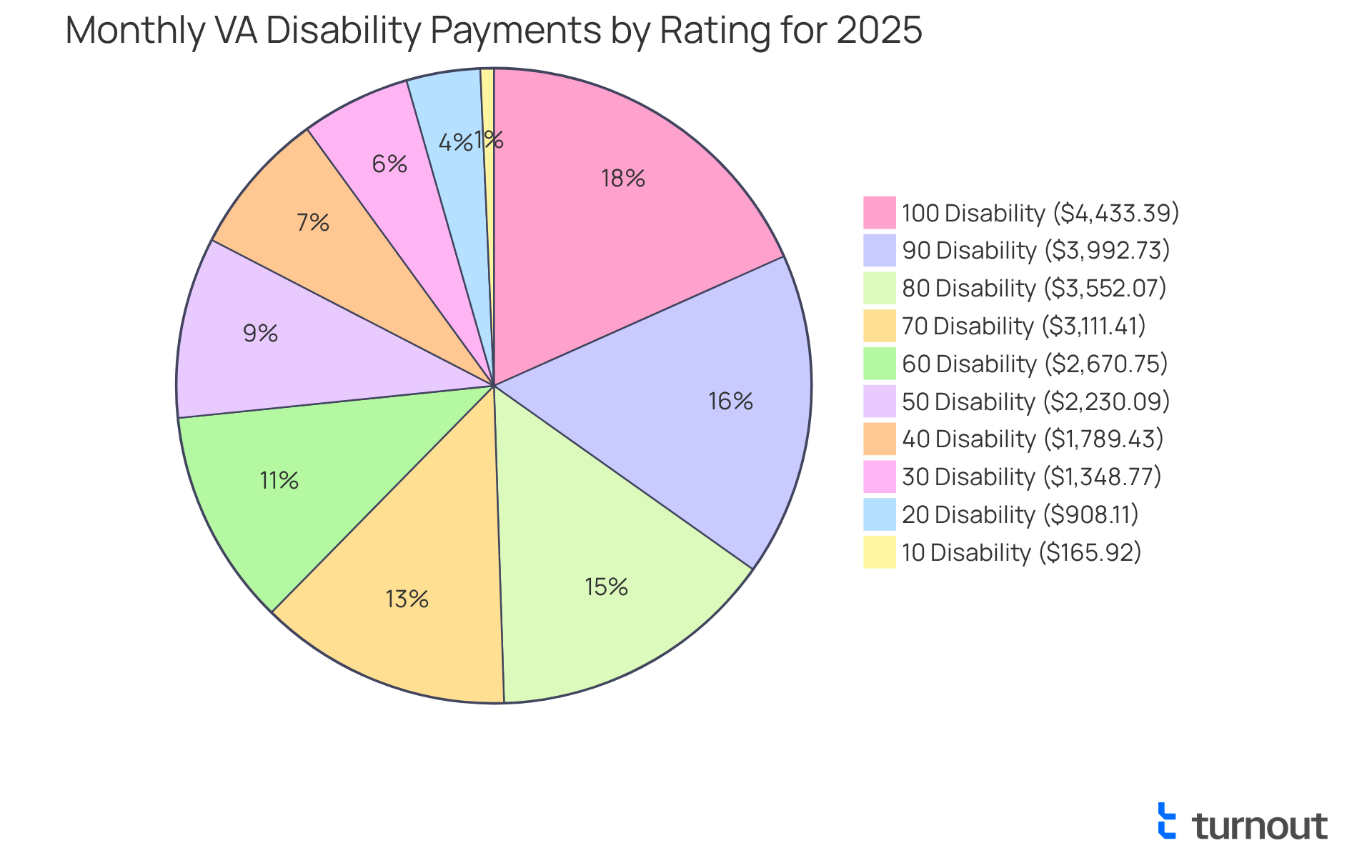
Cost-of-Living Adjustment (COLA) for 2025: What Veterans Should Know
In 2025, the 2025 VA disability pay chart will show that former military personnel will benefit from a 2.5% Cost-of-Living Adjustment (COLA) applied to their disability payments. This adjustment, established by the Compensation Cost-of-Living Adjustment Act of 2024 and signed into law by President Biden on November 25, is crucial for helping our veterans navigate the challenges posed by inflation and the rising cost of living.
The COLA is determined by the Consumer Price Index (CPI), which reflects changes in consumer prices and is vital for preserving the purchasing power of benefits over time. For example:
- Individuals rated at 100% without dependents will see an increase of approximately $93.45 per month.
- Those rated at 10% will receive an additional $4.28 monthly.
As Senator Blumenthal pointed out, "Veterans deserve a fair shake amid the rising costs of housing and inflation," underscoring the importance of these adjustments.
We understand that inflation continues to impact daily costs, and it’s essential for former military personnel to integrate this modification into their financial planning for the upcoming year. A practical tip is to review and adjust monthly budgets to account for the COLA increase. This proactive step can help ensure that veterans effectively manage their finances and maintain their quality of life.
The COLA not only addresses urgent financial needs but also plays a vital role in long-term financial stability for service members and their families. Remember, you are not alone in this journey; we are here to help you navigate these changes and secure a better future.
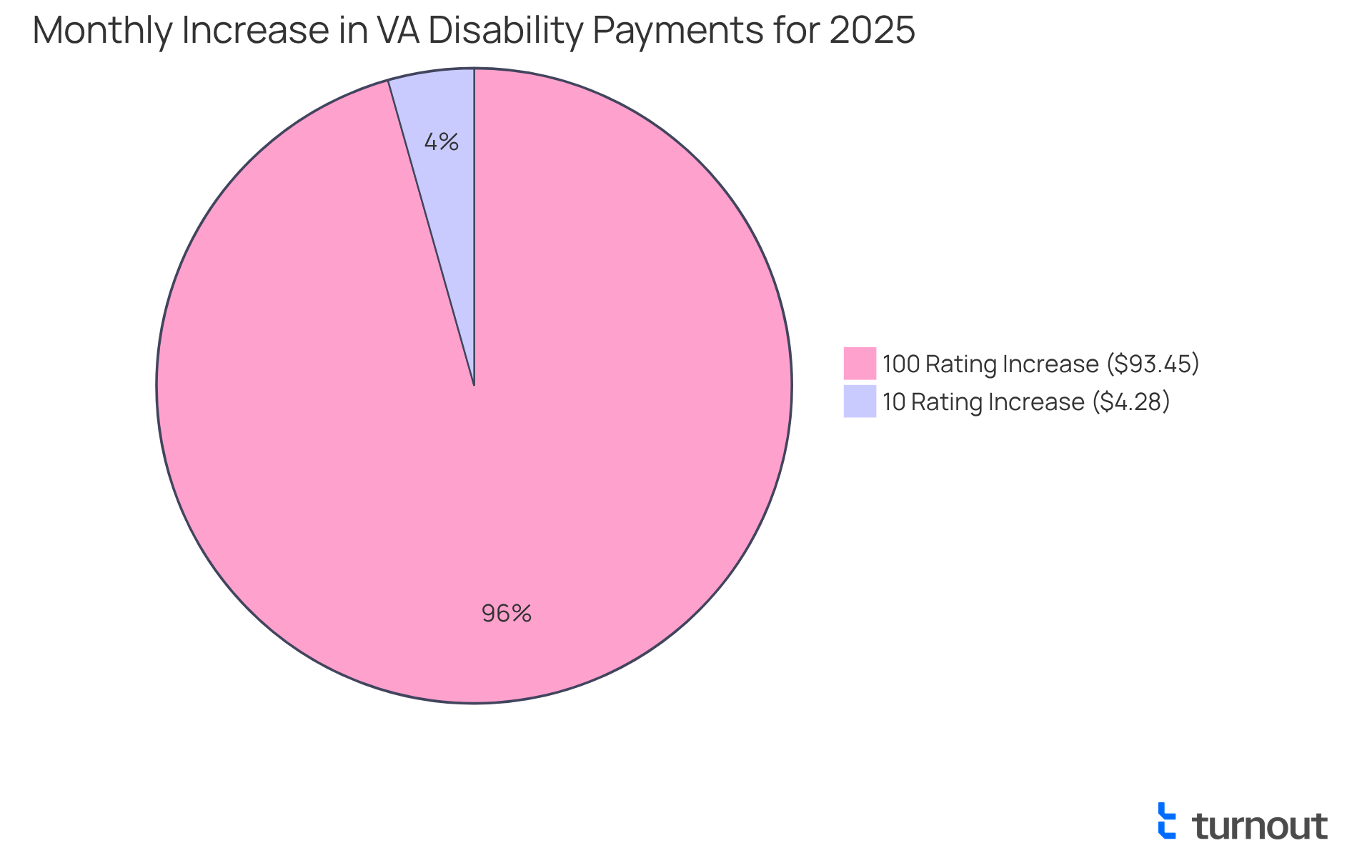
Special Monthly Compensation (SMC): Additional Benefits for Qualifying Veterans
Special Monthly Compensation (SMC) is a tax-exempt assistance provided by the VA for individuals with specific needs arising from service-related impairments. This benefit is particularly crucial for those requiring support and facing significant challenges. In 2025, according to the 2025 VA disability pay chart, the SMC rates reflect the level of care needed, with the SMC-K rate set at $136.06 per month. Importantly, individuals qualifying for SMC-S can receive an additional $446 monthly, while those eligible for SMC-L, which aids individuals needing help with daily living activities, can access up to $913.21 per month.
Eligibility for SMC is determined by various criteria, including the severity of impairments and the need for assistance. For example, individuals who meet the 100 Plus 60 Rule or demonstrate housebound status due to their disabilities may qualify for SMC-S.
We understand that many former service members may not be aware of their rights, which can hinder access to essential financial assistance. By exploring their eligibility for SMC, veterans can enhance their benefits and secure the financial support they deserve. Navigating the VA process can be daunting, but remember, you are not alone in this journey. It's important to understand SMC and seek help in overcoming these challenges.
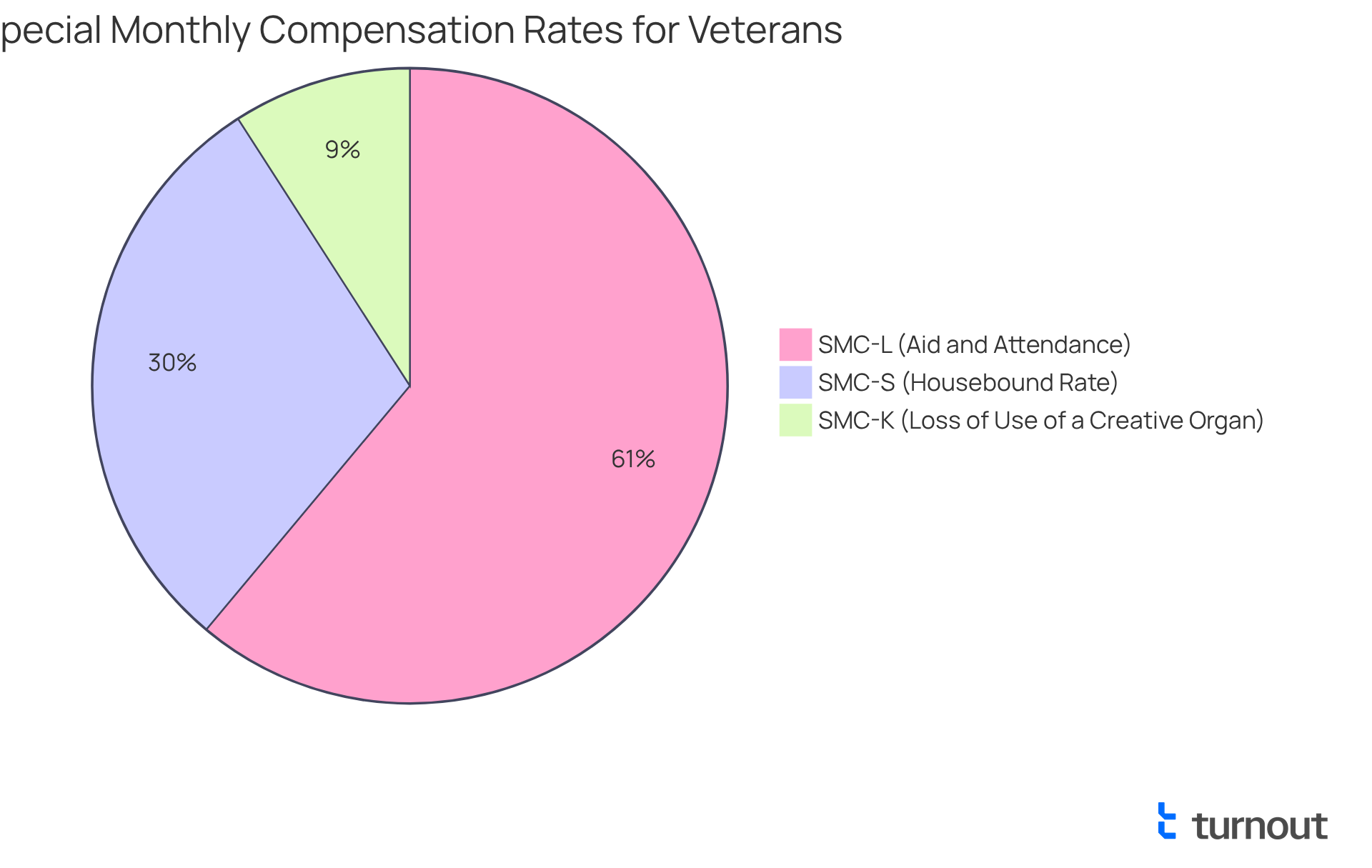
Filing for an Increase: Steps to Boost Your VA Disability Benefits
If you're a veteran looking to increase your VA disability benefits, it's essential to take a systematic approach. Start by gathering all relevant medical records that can support your request for an increase. Then, submit a new request using VA Form 21-526EZ, clearly detailing the reasons for your request. It's crucial to include any new evidence or changes in your condition that justify a reassessment.
We understand that preparing for a possible VA evaluation can feel daunting, but it’s an important step in determining your current impairment status. This organized approach not only simplifies the process but also increases your chances of a successful outcome. Remember, according to the 2025 VA disability pay chart, disability rates will rise by 2.5%, making prompt submissions even more significant.
As Robert Hoffman, an experienced supporter, wisely states, "Individuals who have served our nation deserve the prompt and effective assistance they’ve earned." Utilizing the Fully Developed Claim (FDC) process can also expedite your claims. This allows you to submit all necessary documentation upfront, which can significantly reduce processing times.
You are not alone in this journey, and we’re here to help you navigate the process with compassion and understanding.
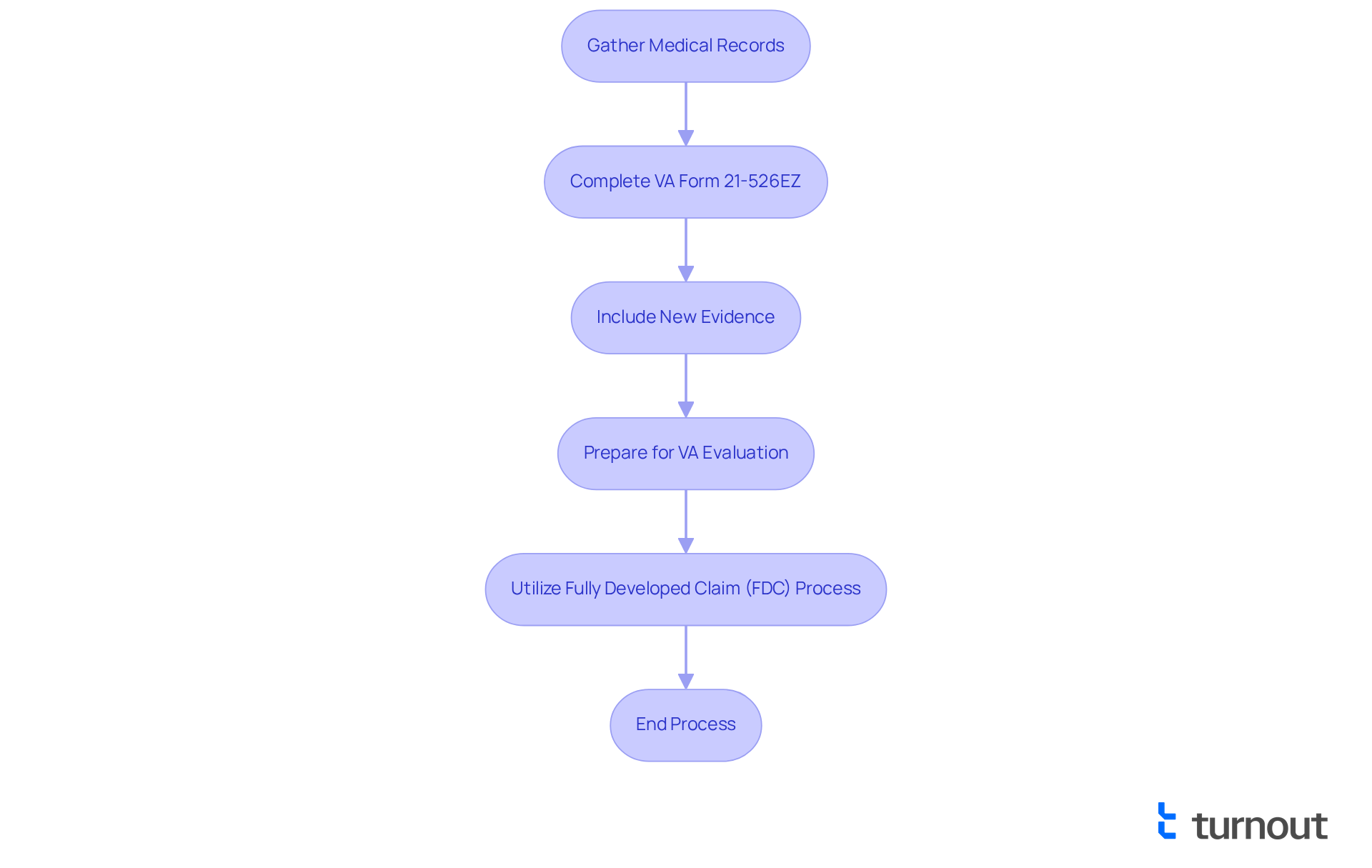
Legislative Changes Impacting VA Disability Benefits in 2025
In 2025, significant legislative changes are set to reshape the VA disability pay chart, particularly concerning eligibility criteria and the expansion of benefits for specific conditions, including mental health disorders. We understand that navigating these changes can be daunting. The VA is expected to implement a more nuanced rating system that reflects the varying degrees of impairment caused by conditions like PTSD and depression. This shift could lead to higher ratings for individuals experiencing severe symptoms, improving their access to essential support.
Additionally, the growth of assumed conditions related to toxic exposures, such as those faced by former service members exposed to burn pits, will streamline the claims process for many. It’s common for veterans to have faced challenges in establishing a service connection for conditions like chronic sinusitis, but under the new guidelines, qualifying for assistance may become simpler. Importantly, veterans who already have established VA ratings will retain their existing ratings, providing reassurance amidst these changes.
We encourage veterans to stay informed about the 2025 VA disability pay chart, as it could greatly influence their eligibility and the assistance available. Collaborating with advocacy organizations, like VA Claims Insider, which offers a systematic approach to managing the process, and closely monitoring VA announcements will be essential for effectively navigating these updates. As one policy expert wisely noted, "Grasping how these legislative updates might influence individual cases is crucial for optimizing advantages." Taking preventive actions, such as submitting requests before new standards are implemented, is vital for protecting your rights and ensuring you receive the compensation you deserve. Remember, you are not alone in this journey; we're here to help.
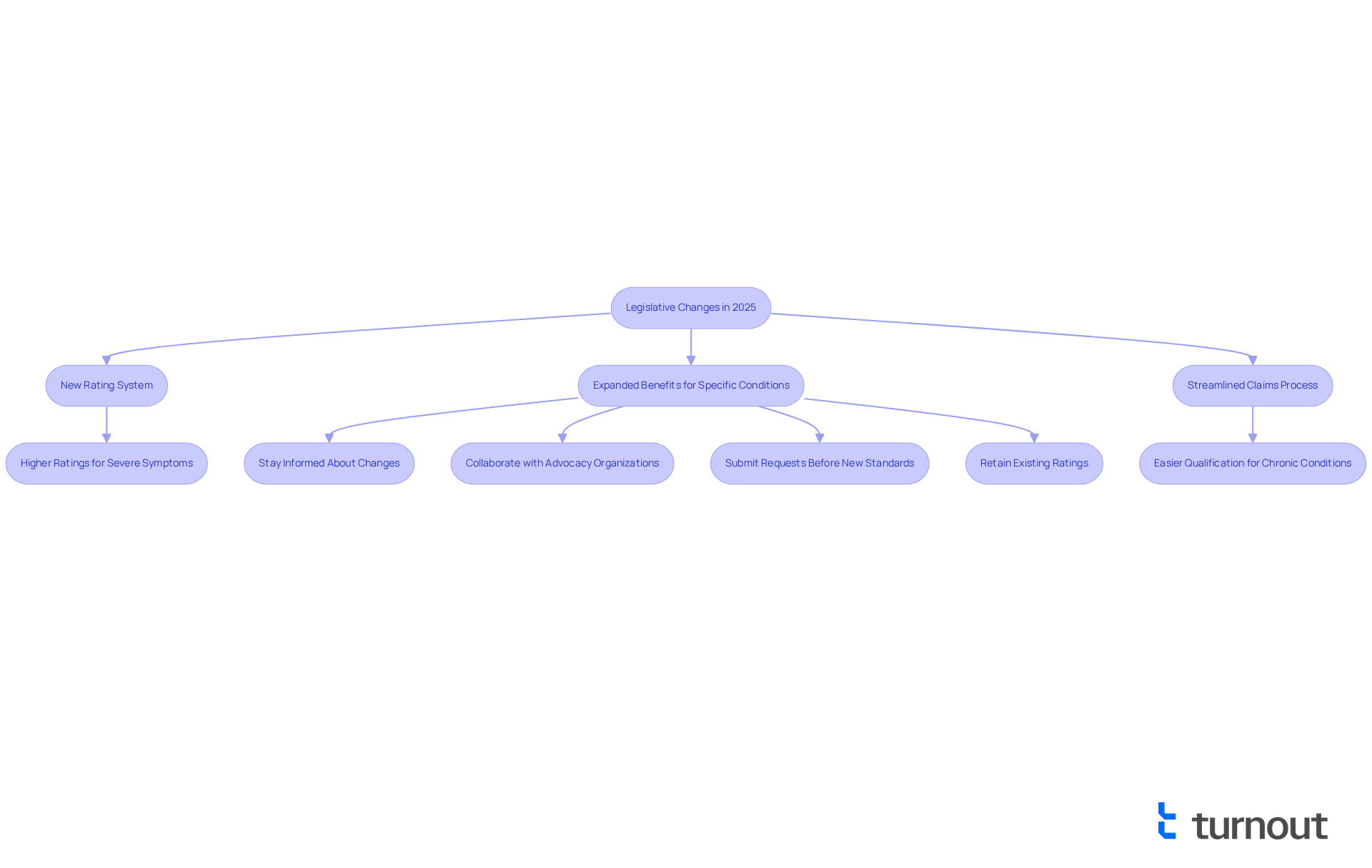
Eligibility Requirements for VA Disability Benefits: What You Need to Know
To be eligible for VA benefits, former military personnel must show they have a service-related condition stemming from an injury or illness sustained during active duty. We understand that navigating this process can be overwhelming. The VA evaluates requests based on medical evidence, service records, and the severity of the disability. Therefore, thorough documentation is essential. Former service members should gather:
- Medical records
- Service history
- Any other relevant information to strengthen their claims
For instance, if individuals were exposed to military burn pits, they may need to provide evidence linking their respiratory issues, like chronic sinusitis or asthma, to their service. It's common to feel uncertain about how to connect these dots. With the introduction of new presumptive conditions related to burn pit exposure, former service members may find it easier to qualify for assistance.
Real-world examples show that those who effectively document their conditions often receive the benefits they deserve. As one veteran shared, "Having all my medical records and service documentation prepared made a significant difference in my application process." This highlights the importance of being organized and meticulous when preparing to present a service-connected condition.
Furthermore, with major revisions to the VA rating system in 2025, understanding the 2025 VA disability pay chart can significantly influence the application process and eligibility. Remember, you are not alone in this journey; we’re here to help you through it.
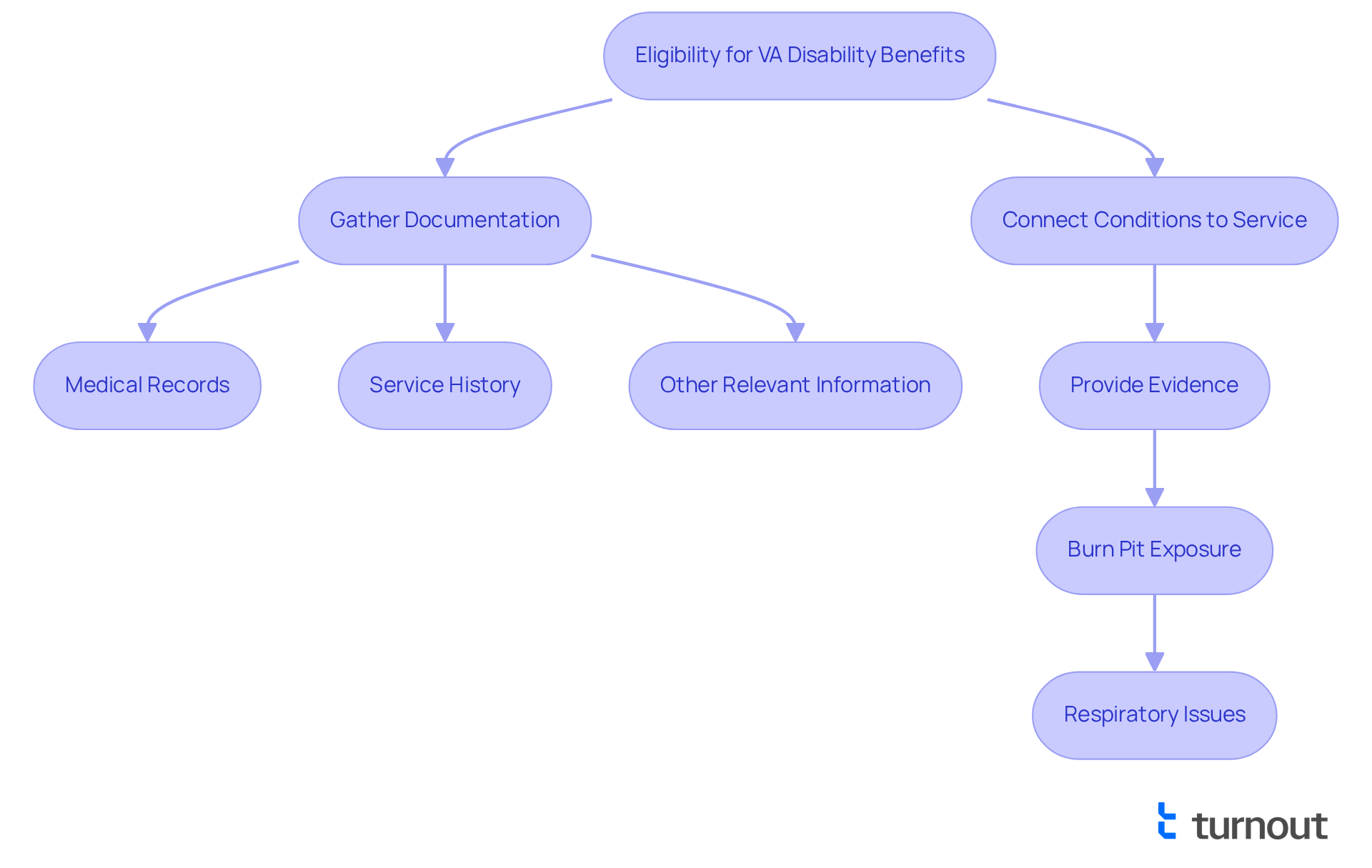
Navigating the VA Disability Application Process: Tips for Success
Navigating the VA benefits application process can feel overwhelming. We understand that many face this challenge, and we’re here to help you enhance your chances of success. First, it’s essential to ensure that all required forms are completed accurately and submitted on time. This attention to detail can make a significant difference.
Next, gather and submit all necessary documentation, including medical records and personal statements. Having everything in order will not only support your application but also ease your mind during this process.
Consider seeking assistance from a qualified advocate or organization that specializes in VA claims. They can provide valuable guidance and support, making the journey less daunting.
Finally, stay organized and keep track of all communications with the VA. Remember, you are not alone in this journey; we’re here to support you every step of the way.
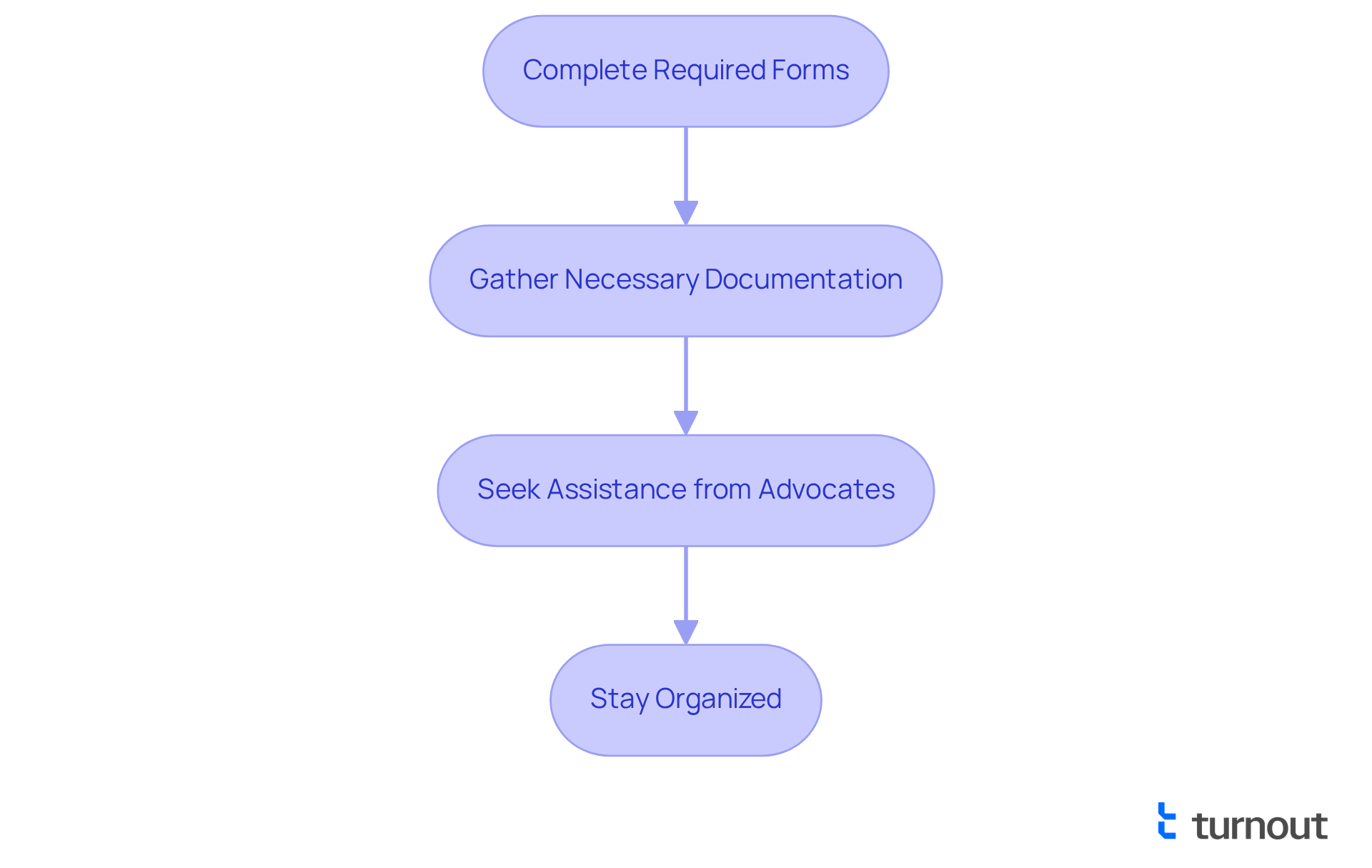
When to Expect Your 2025 VA Disability Payments: A Timeline
According to the 2025 VA disability pay chart, VA payments for veterans in 2025 are typically issued on the first business day of the month following the month they pertain to. For example, payments for January will be disbursed on February 1.
We understand that if the first business day coincides with a holiday or weekend, payments will be made on the last business day of the preceding month. The VA issues direct deposit disability payments on the first of each month, ensuring prompt receipt for individuals.
However, it's common to feel anxious about potential delays due to postal service issues or bank processing. Therefore, it's essential for former service members to plan their finances around these dates.
Veterans should monitor the VA's official announcements for any updates or changes related to the 2025 VA disability pay chart. This will help ensure that their financial strategies remain aligned with expected income.
Financial advisors often suggest establishing a budget that aligns with the timing of these payments. This approach can assist individuals in managing their financial obligations efficiently. For instance, a financial advisor might emphasize, "It's essential to account for the timing of VA payments in your monthly budget to avoid any cash flow issues.
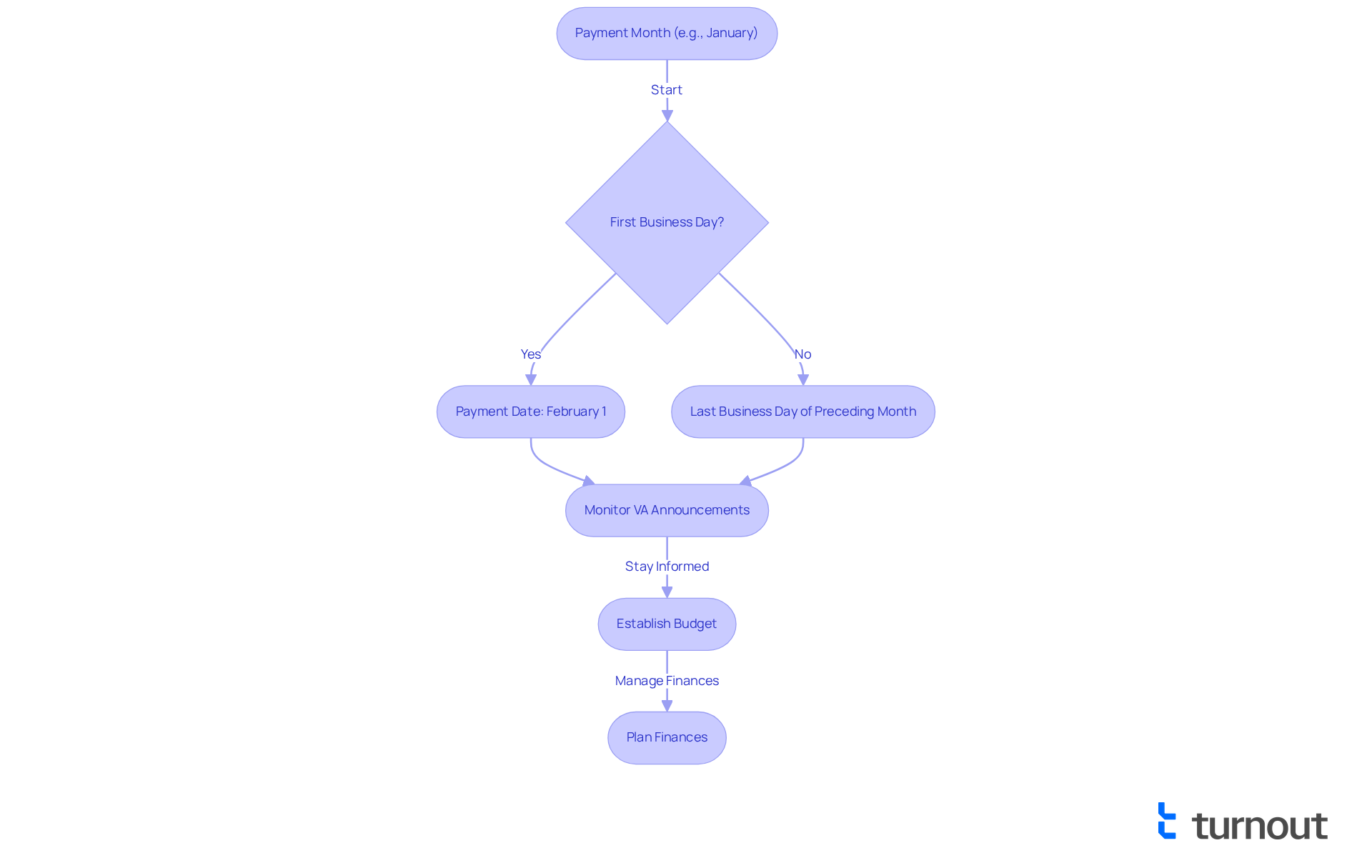
Calculating Combined Disability Ratings: A Guide for Veterans
Calculating combined impairment ratings can feel overwhelming. The VA employs a specific formula, rather than simple addition, which can complicate matters. They round the combined rating to the nearest 10%. For instance, if you have one disability assessed at 50% and another at 30%, the total rating isn't simply 80%. Instead, it’s calculated as follows:
- 50% of the remaining 50% (which is 25%) is added to the initial 50%, resulting in a total rating of 75%, rounded to 80%.
We understand that grasping this process is vital for former service members. It’s important to note that 80% of them are reportedly undervalued by the VA, potentially losing thousands of dollars in compensation. As Brian Reese, founder of VA Claims Insider, emphasizes, "We know the pain of feeling stuck, frustrated, and alone, and we want to make this process as easy and painless as possible for you."
Acquainting yourself with the VA's rating system can empower you to better advocate for your needs and ensure you receive the full benefits you deserve. With possible changes to the VA rating system on the horizon in 2025, staying informed about the 2025 VA disability pay chart is more crucial than ever. Utilizing tools like the disability rating calculator can help you understand your ratings and compensation more effectively. Remember, you are not alone in this journey; we’re here to help.
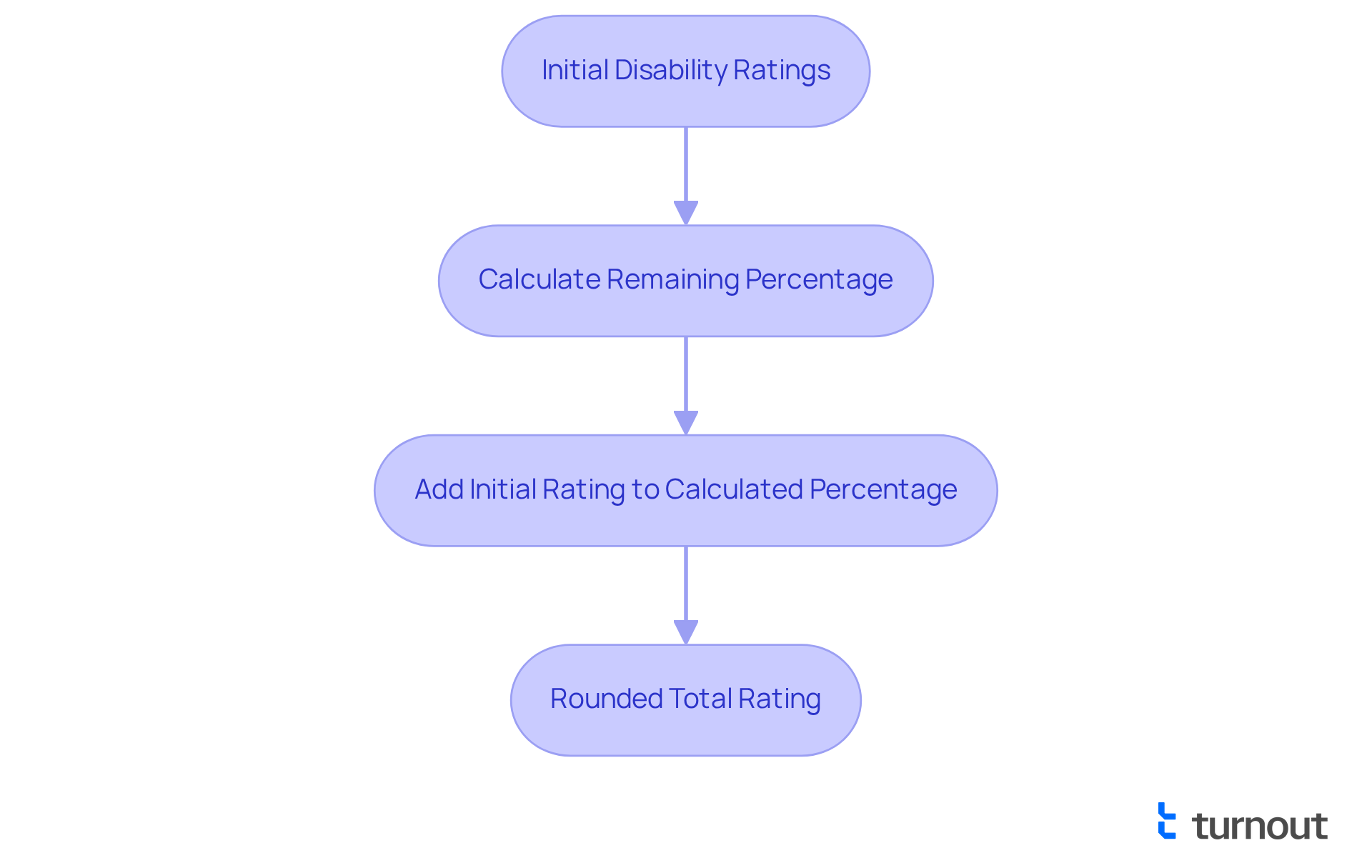
Conclusion
The insights presented regarding the 2025 VA disability pay chart highlight significant advancements and adjustments that are set to benefit former service members. We understand that navigating the claims process can feel overwhelming. However, by integrating innovative technology, such as AI, the process is becoming more streamlined and less intimidating. This ensures that veterans receive the support they need in a timely manner. The enhancements in compensation rates, along with cost-of-living adjustments and special monthly compensation, reflect a commitment to addressing the financial challenges faced by veterans.
Key arguments throughout the article emphasize the importance of understanding the 2025 VA disability pay chart, the legislative changes affecting eligibility, and the proactive steps veterans can take to navigate the application process effectively. It's common to feel unsure about these changes. With the introduction of a more nuanced rating system and resources available for assistance, veterans are equipped to maximize their benefits and secure the support they deserve. The emphasis on thorough documentation and timely submissions further reinforces the need for vigilance in managing claims.
Ultimately, the message is clear: you are not alone in this journey. Continued advocacy, awareness of benefits, and the utilization of available resources can empower former military personnel to reclaim their rightful compensation. As the landscape of VA disability benefits evolves, staying informed and proactive will be essential for ensuring financial stability and access to necessary support. We encourage veterans to engage with advocacy organizations and leverage tools designed to simplify the claims process. Remember, you have earned these benefits, and we’re here to help you receive the full support you deserve.
Frequently Asked Questions
What is Turnout and how does it assist former service members with VA disability claims?
Turnout is an innovative platform that utilizes AI technology to streamline the VA disability claims process for former service members. It provides timely updates, efficient document management, and proactive follow-ups through an AI case quarterback named Jake, making the process more accessible and less intimidating.
How does AI improve the VA disability claims process?
AI enhances the efficiency of VA disability claims by optimizing procedures, reducing the time and effort required for submissions, and providing a personal touch through non-lawyer advocates. This approach helps former service members navigate the complexities of the VA process more effectively.
What are the compensation rates for VA disability in 2025?
The 2025 VA disability pay chart indicates that individuals assessed with a 100% disability will receive approximately $4,433.39 per month, while those evaluated at 10% will receive around $165.92. These rates reflect a 2.5% increase from the previous year.
What is the Cost-of-Living Adjustment (COLA) for 2025, and how does it affect veterans?
In 2025, veterans will benefit from a 2.5% Cost-of-Living Adjustment (COLA) applied to their disability payments, which helps address inflation and rising living costs. For example, individuals rated at 100% without dependents will see an increase of about $93.45 per month.
How is the COLA determined?
The COLA is determined by the Consumer Price Index (CPI), which reflects changes in consumer prices. This adjustment is essential for preserving the purchasing power of benefits over time.
What resources are available to help veterans understand and navigate their benefits?
Resources such as the Mission Roll Call University video series and support from organizations like Veterans Guardian are available to assist veterans in navigating the complexities of their entitlements and optimizing their benefits.
How can veterans prepare for the financial changes brought by the COLA?
Veterans can review and adjust their monthly budgets to account for the COLA increase, which can help them effectively manage their finances and maintain their quality of life amid rising costs.




